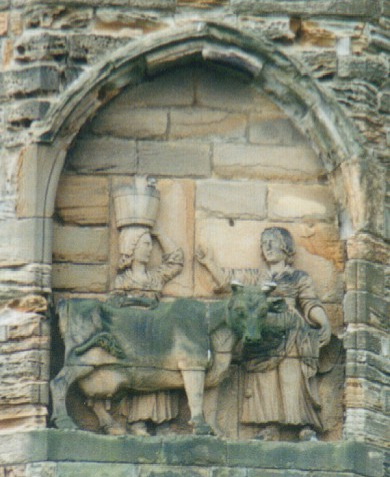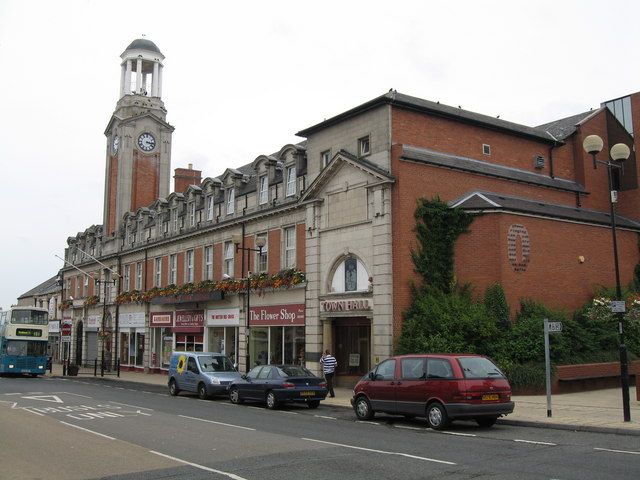|
Croxdale And Hett
Croxdale and Hett is a civil parish in County Durham County Durham, officially simply Durham, is a ceremonial county in North East England.UK General Acts 1997 c. 23Lieutenancies Act 1997 Schedule 1(3). From legislation.gov.uk, retrieved 6 April 2022. The county borders Northumberland and Tyne an ..., England. It is situated approximately four miles south of Durham. The population of the civil parish as taken at the 2011 census was 866. The parish comprises the settlements of: * Croxdale * Hett * Sunderland Bridge For electoral purposes the parish is divided into two wards: * Hett — covers the village of Hett and elects three parish councillors. * Sunderland Bridge — covers the villages of Croxdale and Sunderland Bridge and elects six parish councillors. History The parish was formed on 1 April 1986 from the parishes of Hett, Sunderland Bridge and part of Spennymoor. References External links Civil parishes in County Durham {{Durham-geo-stub ... [...More Info...] [...Related Items...] OR: [Wikipedia] [Google] [Baidu] |
Civil Parish
In England, a civil parish is a type of administrative parish used for local government. It is a territorial designation which is the lowest tier of local government. Civil parishes can trace their origin to the ancient system of parishes, which for centuries were the principal unit of secular and religious administration in most of England and Wales. Civil and religious parishes were formally split into two types in the 19th century and are now entirely separate. Civil parishes in their modern form came into being through the Local Government Act 1894 ( 56 & 57 Vict. c. 73), which established elected parish councils to take on the secular functions of the parish vestry. A civil parish can range in size from a sparsely populated rural area with fewer than a hundred inhabitants, to a large town with a population in excess of 100,000. This scope is similar to that of municipalities in continental Europe, such as the communes of France. However, unlike their continental Euro ... [...More Info...] [...Related Items...] OR: [Wikipedia] [Google] [Baidu] |
County Durham
County Durham, officially simply Durham, is a ceremonial county in North East England.UK General Acts 1997 c. 23Lieutenancies Act 1997 Schedule 1(3). From legislation.gov.uk, retrieved 6 April 2022. The county borders Northumberland and Tyne and Wear to the north, the North Sea to the east, North Yorkshire to the south, and Cumbria to the west. The largest settlement is Darlington. The county has an area of and a population of . The latter is concentrated in the east; the south-east is part of the Teesside urban area, which extends into North Yorkshire. After Darlington, the largest settlements are Hartlepool, Stockton-on-Tees, and Durham, England, Durham. For Local government in England, local government purposes the county consists of the Unitary authorities of England, unitary authority areas of County Durham (district), County Durham, Borough of Darlington, Darlington, Borough of Hartlepool, Hartlepool, and part of Borough of Stockton-on-Tees, Stockton-on-Tees. Durham Count ... [...More Info...] [...Related Items...] OR: [Wikipedia] [Google] [Baidu] |
Durham, England
Durham ( , locally ) is a cathedral city and civil parish in the county of County Durham, Durham, England. It is the county town and contains the headquarters of Durham County Council, the unitary authority which governs the district of County Durham (district), County Durham. The built-up area had a population of 50,510 at the 2021 Census. The city was built on a meander of the River Wear, which surrounds the centre on three sides and creates a narrow neck on the fourth. The surrounding land is hilly, except along the Wear's floodplain to the north and southeast. Durham was founded in 995 by Anglo-Saxon monks seeking a place safe from Viking Age, Viking raids to house the relics of St Cuthbert. The church the monks built lasted only a century, as it was replaced by the present Durham Cathedral after the Norman Conquest; together with Durham Castle it is a UNESCO World Heritage Site. From the 1070s until 1836 the city was part of the County Palatine of Durham, a semi-independ ... [...More Info...] [...Related Items...] OR: [Wikipedia] [Google] [Baidu] |
United Kingdom Census 2011
A Census in the United Kingdom, census of the population of the United Kingdom is taken every ten years. The 2011 census was held in all countries of the UK on 27 March 2011. It was the first UK census which could be completed online via the Internet. The Office for National Statistics (ONS) is responsible for the census in England and Wales, the General Register Office for Scotland (GROS) is responsible for the census in Scotland, and the Northern Ireland Statistics and Research Agency (NISRA) is responsible for the census in Northern Ireland. The Office for National Statistics is the executive office of the UK Statistics Authority, a non-ministerial department formed in 2008 and which reports directly to Parliament. ONS is the UK Government's single largest statistical producer of independent statistics on the UK's economy and society, used to assist the planning and allocation of resources, policy-making and decision-making. ONS designs, manages and runs the census in England an ... [...More Info...] [...Related Items...] OR: [Wikipedia] [Google] [Baidu] |
Croxdale
Croxdale is a village in the civil parish of Croxdale and Hett, situated about south of Durham City, in County Durham, England and on the A167 road, formerly part of the Great North Road. It is on the route of the East Coast Main Line and at one time had a station. The railway crosses over Croxdale Viaduct, built in 1872, just north of the village. The Weardale Way long distance footpath passes through the nearby Croxdale Hall estate. History The village originates from a small settlement around Croxdale Hall which is about half a mile to the north east of the modern village. First mentioned in records as Crokesteil in 1195 the name may come from a Viking named Krokr and the shape of the river bends that meander like a tail. Ownership of Croxdale dates back to 1291 when it was owned by a Roger Routhberi. By the 1350s ownership of Croxdale had passed to Robert de Whalton a treasurer of Brittany. De Whalton's granddaughter Agnes married a Gerard Salvin in 1409 and the Croxdale es ... [...More Info...] [...Related Items...] OR: [Wikipedia] [Google] [Baidu] |
Hett, County Durham
Hett is a village and former civil parish, now in the parish of Croxdale and Hett, in the County Durham (district), County Durham district, in the ceremonial county of County Durham, Durham, England. It is situated a few miles south of Durham, England, Durham. Hett is largely surrounded by farmland. To the south, Rapeseed, rape fields are predominant while at the northern end, cattle are grazed all year round. To the north-west of Hett lies Sunderland Bridge, County Durham, Sunderland Bridge, a small hamlet with a population of under 50 people (2004). Hett contains a small pond, village hall and a football pitch. Hett gives its name to an igneous dyke (geology), dyke which cuts through the local Coal Measures rocks. Hett is under the constituency of City of Durham (UK Parliament constituency), Newton Aycliffe and Spennymoor Etymology The name ''Hett'' is of Old English origin. The name originates with the term ''hætt'' (> "a hat"), which topographically refers to a hill thou ... [...More Info...] [...Related Items...] OR: [Wikipedia] [Google] [Baidu] |
Sunderland Bridge, County Durham
Sunderland Bridge is a bridge just outside the village also called Sunderland Bridge in County Durham, England. It lies close to the confluence of the River Wear and River Browney. Sunderland Bridge originally carried the Great North Road (A1) across the River Wear, and probably dates back to the 14th century. It is built of dressed sandstone with four semicircular arches. The bridge has undergone several rebuilds, with the end arches being rebuilt in 1770, the parapets widened in 1822, and new end walls built in the 19th century. It is a Grade I listed structure In the United Kingdom, a listed building is a structure of particular architectural or historic interest deserving of special protection. Such buildings are placed on one of the four statutory lists maintained by Historic England in England, Hi .... When a new bridge was needed as the existing bridge was not wide enough to cope with traffic, Croxdale Bridge was constructed to the east of the existing bridge. Th ... [...More Info...] [...Related Items...] OR: [Wikipedia] [Google] [Baidu] |
Election
An election is a formal group decision-making process whereby a population chooses an individual or multiple individuals to hold Public administration, public office. Elections have been the usual mechanism by which modern representative democracy has operated since the 17th century. Elections may fill offices in the legislature, sometimes in the executive (government), executive and judiciary, and for local government, regional and local government. This process is also used in many other private and business organizations, from clubs to voluntary association and corporations. The global use of elections as a tool for selecting representatives in modern representative democracies is in contrast with the practice in the democratic archetype, ancient History of Athens , Athens, where the elections were considered an oligarchy , oligarchic institution and most political offices were filled using sortition, also known as allotment, by which officeholders were chosen by lot. ... [...More Info...] [...Related Items...] OR: [Wikipedia] [Google] [Baidu] |
Ward (politics)
A ward is a local authority area, typically used for electoral purposes. In some countries, wards are usually named after neighbourhoods, thoroughfares, parishes, landmarks, geographical features and in some cases historical figures connected to the area (e.g. William Morris Ward in the London Borough of Waltham Forest, England). It is common in the United States for wards to simply be numbered. Origins The word "ward", for an electoral subdivision, appears to have originated in the Wards of the City of London, where gatherings for each ward known as "wardmotes" have taken place since the 12th century. The word was much later applied to divisions of other cities and towns in England and Wales and Ireland. In parts of northern England, a ''ward'' was an administrative subdivision of a county, very similar to a hundred in other parts of England. Present day In Australia, Canada, New Zealand, South Africa, Sri Lanka, the United Kingdom, and the United States, wards are an e ... [...More Info...] [...Related Items...] OR: [Wikipedia] [Google] [Baidu] |
Spennymoor
Spennymoor is a town and civil parish in County Durham, England. It is south of the River Wear and is south of Durham. The civil parish includes the villages of Kirk Merrington, Middlestone Moor, Byers Green and Tudhoe. In 2011 the parish had a population of 19,816. History Origins The land on which Spennymoor now stands was once a vast expanse of moorland covered with thorn and whin bushes (Spenny Moor). In 1336 its place-name was recorded as ''Spendingmor''. The name is probably derived from the Old English or Old Norse ''spenning'' and ''mōr'', meaning a moor with a fence or enclosure. Another theory of the place-name's origin is from the Latin ''spina'', meaning thorn (possibly from the Roman influence at Binchester) combined with the Old English or Old Norse ''mōr''. CE Jackson, in his ''Place Names of Durham'' published in 1916 suggested a combination of the Old Norse ''spaan'' with Old English ''mar'', meaning the moor named after the shingle-hut erected thereon ... [...More Info...] [...Related Items...] OR: [Wikipedia] [Google] [Baidu] |




